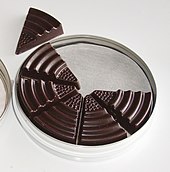Scho-Ka-Kola
Scho-Ka-Kola is a brand name for highly caffeine-containing chocolate and a Selbiger with pieces added fruit nut mixture ( " trail mix ") is used. The chocolates have a caffeine content of around 0.2 percent, which results from the cocoa content of 58 percent and the addition of 2.6 percent roasted coffee and 1.6 percent kola nut powder . The chocolate is sold in portions in triangular pieces in red and white or blue and white round tin cans as well as in regular bars. The recipe and design have only changed slightly since the introduction of chocolate.
history
In 1935, Scho-Ka-Kola was invented in Berlin by the Hildebrand, Kakao- und Schokoladenfabrik GmbH company and introduced as “sports chocolate” the following year on the occasion of the 1936 Summer Olympics . It was also produced by the chocolate manufacturer Sprengel in Hanover , which was therefore recognized in 1936 as an important company for the military economy . During the Second World War it was known colloquially as "Aviator's Chocolate" because it was part of the Air Force catering, but also the catering for other branches of armed forces, e.g. B. the submarine crews or the army . In this context, she also played a key role in the 1959 film Rosen for the Public Prosecutor .
In 1969 Hans Imhoff took over the Hildebrand Kakao- und Schokoladenfabrik GmbH. He bought Stollwerck AG from Deutsche Bank in 1971 , so that sales were then carried out via Stollwerck. In 2005, Scho-Ka-Kola GmbH, based in Norderstedt, took over all trademark rights, recipes and distribution. The first entry of Scho-Ka-Kola GmbH in the commercial register dates from September 19, 2006. This company was liquidated on February 13, 2017 by resolution of the shareholders' meeting. The trademark rights, recipes and distribution of Scho-Ka-Kola then became the property of Genuport Trade GmbH, which is also based in Norderstedt.
Others
- In addition to the common dark chocolate in a red and white can, there is also a whole milk variant in a blue and white can, and there was the whole milk and nut variety in a green and white can.
- Until a few years ago (as of 2007), chocolate consisted of two round bars that were shaped like a cake and that you had to break open to eat. Today the segments are already separated from each other.
- In the meantime, the chocolate was also available as a rectangular bar in normal paper packaging.
- A can of 100 g has a caffeine content of around 200 mg. Since a can contains 16 corners (two levels with eight corners each), one corner has a caffeine content of approx. 12.5 mg caffeine.
- The can says: “8 corners of Scho-Ka-Kola contain about as much caffeine as a cup of coffee”. This amount corresponds roughly to the caffeine content of an energy drink (80 mg per can of 250 ml). An earlier packaging label read: "4 corners of Scho-Ka-Kola contain about as much caffeine as a strong espresso " (approx. 50 mg).
- A common misconception is that the Scho-Ka-Kola used to contain methamphetamine . This is due to the fact that it was part of the Luftwaffe's equipment during World War II. There it was called Aviator's Chocolate , which suggests the reference to Pervitin, also known as tank chocolate . However, Pervitin was referred to as aviator marzipan in the Air Force .
Web links
Individual evidence
- ↑ Years of Energy Chocolate - The famous cult brand Scho-Ka-Kola is celebrating its anniversary Ulig, PR & Communication, April 6, 2015
- ^ North Data Scho-Ka-Kola GmbH
- ^ North Data Scho-Ka-Kola GmbH
- ↑ Crystal meth for Hitler's soldiers. (Die Welt, March 13, 2015), accessed June 4, 2016

